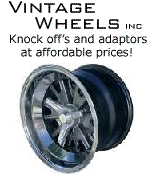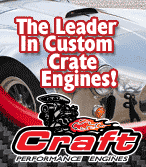 
 Main Menu
Main Menu
|
 Nevada Classics
Nevada Classics
|
 Advertise at CC
Advertise at CC
|
 December 2025
December 2025
|
| S |
M |
T |
W |
T |
F |
S |
| |
1 |
2 |
3 |
4 |
5 |
6 |
| 7 |
8 |
9 |
10 |
11 |
12 |
13 |
| 14 |
15 |
16 |
17 |
18 |
19 |
20 |
| 21 |
22 |
23 |
24 |
25 |
26 |
27 |
| 28 |
29 |
30 |
31 |
|
|
|
|
 CC Advertisers
CC Advertisers
|
|

04-06-2001, 11:46 PM
|
 |
CC Member

|
|
|
Join Date: Oct 2000
Location: Portland, OR, USA,
Posts: 155
|
|

 Not Ranked
Not Ranked
Anyone installed lap & shoulder belt in their snake? The 4/5 point harness is a bit much for my needs, but the lap belt only seems like a bad idea. I'd like to put in lap&shoulder, but I'm not sure where I'd mount it, and how uncomfortable it will be if it's far down below the shoulder, or whether that's even safe.
Any ideas?
|

04-07-2001, 04:57 AM
|
|
CC Member

|
|
|
Join Date: Dec 2000
Cobra Make, Engine: Superformance '533'
Posts: 134
|
|

 Not Ranked
Not Ranked
I see you don't have a roll bar. If you did Finish Line has mounting kit for shoulder harness. In lieu of that you may have to weld
a bar behind the seats (trunk area)to mount to. Sorry I can't be more help, but I am not familiar with you car manufacturer. In any event I think the idea of shoulder belts is a good one.
Good Luck
|

04-09-2001, 02:09 AM
|
|
Senior Club Cobra Member

|
|
|
Join Date: Feb 1999
Location: New Britain, CT,
Posts: 1,416
|
|

 Not Ranked
Not Ranked
Shoulder harness mounts should be mounted high - close to shoulder level or higher. Otherwise you will be pushed down, not held back in the seat.
Bob Putnam -ERA-
|

04-09-2001, 06:56 AM
|
 |
CC Member

|
|
|
Join Date: Oct 2000
Location: Portland, OR, USA,
Posts: 155
|
|

 Not Ranked
Not Ranked
This makes sense, though I guess it's a simple physics thing. If it went down and back at a 45 degree angle, there'd be roughly as much force pushing downward as pushing forward.
The question is, if that is my only option (I don't have a rollbar to bolt it too), is this better than lap-belts alone?
Also, don't people with the 4-point harness have the same problem if it goes down and back (not bolted to a rollbar)? I've seen several like this in pictures.
KP
|

04-10-2001, 04:21 PM
|
 |
Senior Club Cobra Member

|
|
|
Join Date: Sep 2000
Location: Holderness, NH, US of A,
NH
Cobra Make, Engine: CSX 4772 old iron FE
Posts: 5,499
|
|

 Not Ranked
Not Ranked
Kim, you bring up a good point that I am nowhere near dealing with at the moment. I suggest looking at an SCCA rulebook as it has a good section on this that has been developed in conjunction with the school of hard knocks. It shows some good safe mounting and positioning practices. If you can't get hold of one I'll try and copy and post from my last rulebook.
Be safe Cheers Mickmate
|

04-12-2001, 10:01 AM
|
 |
CC Member

|
|
|
Join Date: Aug 1999
Cobra Make, Engine:
Posts: 2,888
|
|

 Not Ranked
Not Ranked
The instructions that come with all Simpson belts says to mount the shoulder belts about 4" below the shoulder.
X
|

04-12-2001, 12:41 PM
|
|
Guest

|
|
|
|
|

HI KIM,
I AGREE WITH X-99 REGARDING MOUNT POINTS SLIGHTLY BELOW SHOULDER LEVEL.
I HAVE AN EXCALIBUR (WHICH IS BASICALLY A C.R. KNOCK-OFF). IT CAME FROM THE FACTORY WITH A THREE POINT LAP/SHOULDER CROSSOVER SYSTEM. THE "HIGH" ATTACH POINT (WITH THE INERTIA REEL) IS LOCATED ON TOP OF THE 1" X 3" STEEL CROSSMEMBER THAT RUNS DIRECTLY BEHIND THE SEATS. IT IS MOUNTED OUTSIDE OF THE SEATS BY A FEW INCHES. I'M NOT ABSOLUTELY CERTAIN BUT I BELIEVE THAT IT IS FASTENED WITH 1/2" NUT-SERT. (AS AN ALTERNATIVE TO THE "NUT-SERT" YOU COULD DRILL STRIGHT THRU THE CROSSMEMBER AND ATTACH A LOCK-NUT FROM THE UNDERSIDE OF THE CAR. I LIKE THIS METHOD BETTER ANYWAY.) THE TWO "LOWER" ATTACH POINTS CAN BE THE SAME ONES USED BY A "LAP BELT".
I THOUGHT ABOUT REPLACING MY THREE POINT WITH A FOUR POINT SYSTEM. ONE OF MY GIRL FRIENDS TALKED ME OUT OF IT. SHE IS RATHER ADEQUATELY ENDOWED (AS IN DARN NEAR DE-FORMED) AND THE THREE POINT CROSSES OVER HER CHEST IN A MUCH MORE COMFORTABLE FASHION. SHE REFUSES TO USE THE SHOULDER STRAPS IN MY ERA COBRA (FOUR POINT SYSTEM) BRCAUSE OF THE DISCOMFORT. (I'M NOT CERTAIN THAT THEY'RE LONG ENOUGH ANYWAY).
FOR JUST CRUISING THE THREE POINT SYSTEM IS NICE. REMEMBER THAT THE EXCALIBUR COBRAS MET *ALL* DOT REQUIREMENTS AND ARE STREET LEGAL IN ALL 50 STATES.
IF YOU NEED ANY MORE INFO OR MEASUREMENTS LET ME KNOW.
Y'ALL HAVE A REALLY GREAT DAY,
BLACKJACK

|

04-13-2001, 06:23 AM
|
 |
CC Member

|
|
|
Join Date: Oct 2000
Location: Portland, OR, USA,
Posts: 155
|
|

 Not Ranked
Not Ranked
Thanks for posting that info. It's useful. Possible to get a picture or two posted?
So I'm assuming that shoulder mount location sits a good 6" below the height of your shoulder. Is it uncomfortable? Does it rub against your neck, or slip off your shoulder?
Thanks,
KP
P.S. Sorry to hear about your girlfriends horrible deformity. You have my sympathy. Oops no, that's actually envy.
|

04-13-2001, 06:23 AM
|
 |
CC Member

|
|
|
Join Date: Oct 2000
Location: Portland, OR, USA,
Posts: 155
|
|

 Not Ranked
Not Ranked
Thanks for posting that info. It's useful. Possible to get a picture or two posted?
So I'm assuming that shoulder mount location sits a good 6" below the height of your shoulder. Is it uncomfortable? Does it rub against your neck, or slip off your shoulder?
Thanks,
KP
P.S. Sorry to hear about your girlfriends horrible deformity. You have my sympathy. Oops no, that's actually envy.
|

04-13-2001, 06:28 AM
|
 |
Charter Club Cobra Member

|
|
|
Join Date: Jan 1999
Location: Sublimity,,
OR
Cobra Make, Engine: My Shell Valley Coupe is here! Now the building begins....
Posts: 1,409
|
|

 Not Ranked
Not Ranked
Just to understand completly, pictures of the girlfriend would be helpful too. 
Scott S
|

04-13-2001, 07:09 AM
|
|
Guest

|
|
|
|
|

Please folks, use caution when it comes to shoulder harnesses. I beg to differ with Bob on this topic. Five point harness assemblies (particularly the shoulder harness) absolutely must not be mounted higher than the shoulder. It’s an invitation for disaster or worse. I’ll be blunt: You can kill yourself with that approach.
As some of you know, I’ve been involved in racing for quite some time – and all of it with the NHRA (National Hot Rod Association). I’m also an employee of the NHRA. What you might not know is that we have one of the most comprehensive sets of safety regulations in all of motorsports. We also have an admirable record of keeping people alive in race cars. Seat belt and harness mounting is definitely part of the regulations. While a three point harness, as you will find in almost every passenger car on the planet is designed to function with a high shoulder harness mounting point, that same location can (and regularly will) prove fatal when applied to a race-style dual mount shoulder harness. Here are two excerpts from the NHRA Rule Book:
SECTION 10:5 DRIVER RESTRAINT SYSTEMS
"A quick-release, 3-inch shoulder harness meeting SFI Spec 16-1 is mandatory in all cars in competition required by the rules to have a roll bar or a roll cage (Permitted in all other classes). Driver restraint system must be clearly labeled as meeting SFI Spec 16.1 and dated by manufacturer. System must be updated at two-year intervals from date of manufacture. All seat belt and shoulder harness installations must be originally designed to be used with each other and produced by the same manufacturer. For harness installation, see illustration. Cars using OEM or OEM-type seat may route crotch strap in front of seat instead of through seat. Only those units that release all five attachment points in one motion are permitted. When arm restraints are worn with a restraint system that utilizes a "latch lever", a protective cover must be installed to prevent arm restraint from accidentally releasing the latch lever. Protective cover not required if system utilizes "duck-bill" latch hardware. All harness sections must be mounted to the frame, cross member, or reinforced mounting, and installed to limit driver's body travel both upward and forward. Seat belts may not be wrapped around lower frame rails. Under no circumstances are bolts inserted through bolt webbing permitted for mounting. Check manufacturer's instructions."
SECTION 10:11 SEAT BELTS
"All cars not required by Class Requirements to use SFI 16.1 driver restraint systems must be equipped with an accepted quick release-type driver seat belt (All cars in competition requiring a roll bar or a roll cage, or as outlined by Class Requirements, require a five-point, 3-inch wide SFI 16.1 restraint system. See 10:5 DRIVER RESTRAINT SYSTEM). Belts must be securely fastened to the frame, cross member or reinforced mounting so that all fittings are in a direct line with the direction of pull. Seat belts may not be wrapped around lower frame rails or any frame rail or cross member, such that belt may be damaged in event that frame rail or cross member comes in contact with racing surface. Steel castings of the type recommended by the FAA or U-bolt-type mounts are permitted. If used for installation, flat steel plates must be a minimum of 1/4-inch thickness and have rounded edges to prevent cutting seat belts. Under no circumstances can belts be installed with bolts through webbing. In all cars with fiberglass floors, a cross member (minimum 2-inch X 2-inch X .083-inch wall thickness square tubing) must be installed between frame rails for proper driver's seat belt installation."
As you can see, harness assemblies must be used with some form of crotch strap. Otherwise you will submarine (downward) out of the belt during impact. Also, harnesses must be mounted in a location either level with the shoulders or a maximum of four inches below the shoulder. A mount that is higher than shoulder level is not acceptable.
If it works, I’ve included a GIFF that shows the accepted harness mounting arrangement. If, by chance the GIFF doesn’t show up, please feel free to contact me and I’ll gladly e-mail a copy to you.
Sincerely,
Wayne Scraba
Wayne Scraba Motorsports
Kirkham Owner & Dealer
PH: 250-658-4222
E-Mail: wcscraba@coastnet.com


|

04-13-2001, 07:20 AM
|
|
Senior Club Cobra Member

|
|
|
Join Date: Feb 1999
Location: New Britain, CT,
Posts: 1,416
|
|

 Not Ranked
Not Ranked
Mounting the harnesses low is fine - if you are using a crotch belt to keep you from submarining. On the street, and without the crotch strap, I still prefer a higher mounting. The percentage of rollovers is higher on the race track than the street, while head-ons are proportionally fewer, and the track harnesses specs reflect that special need.
Bob P. -ERA-
|

04-13-2001, 07:52 AM
|
|
Guest

|
|
|
|
|

You’re entitled to your opinion Bob. And you can believe what you wish. In drag racing, the chance of frontal impact, first into a concrete barrier wall, sometimes followed by a roll-over is the norm, rather than the exception. I stand firm on the NHRA regulations. I suggest you contact: Stroud Safety Equipment, Simpson Safety or Deist Safety and solicit their points of view.
In addition, I also suggest you contact either David or Thomas Kirkham and ask for a copy of a Victory Lane (magazine) article printed on seat belts and shoulder harness. I believe the URL for this article has been posted previously on this board. This article documents proper mounting locations and sources General Motors’ considerable research into race car safety. The information provided is contrary to your belief.
You may find that your convictions are not in parallel with other industry professionals, or racing industry sanctioning bodies with considerable experience in this arena.
From my perspective, I will continue to recommend to my customers and friends to follow the NHRA regulations when it comes to safety equipment mounting and use.
Sincerely,
Wayne Scraba
Wayne Scraba Motorsports
Kirkham Owner & Dealer

|

04-13-2001, 08:51 AM
|
|
Senior Club Cobra Member

|
|
|
Join Date: Feb 1999
Location: New Britain, CT,
Posts: 1,416
|
|

 Not Ranked
Not Ranked
Wayne,
I have absolutely no objection to the competition requirements, but the original question was about a street setup, and that was the question that I answered. I haven't seen the National specs (NHTSA?) for production cars, but they inevitably have their shoulder mountings up high unless there ain't no place there to attach to.
Bob P. -ERA-
[This message has been edited by Bob Putnam (edited 04-13-2001).]
|

04-13-2001, 02:51 PM
|
|
Guest

|
|
|
|
|

Bob…I understand the question completely, but there is a considerable difference between the type of belt installed in a passenger car and the type commonly used in Cobras or race cars. In a typical passenger car, the belt latch is off to one side (commonly on the extreme lower right for the driver and on the extreme lower left for the passenger). In this case, the shoulder “strap” is routed diagonally across the body. Because of the 3-point arrangement, it is possible to use a high mounting location for the shoulder strap. This is not the case with a five point harness. In order to determine the correct mounting (anchor) points in the given production vehicle (passenger car, light truck, etc.), it is obviously heavily instrumented and crash tested (and likely many more times than once). As you must be aware, the mounting point location for three point belts in a passenger car application is not an arbitrary decision.
In contrast, the race lap belts commonly used are latched in the center. As a result, the shoulder harness is latched in the center, not diagonally. Because of this, you must use the appropriate harness for the belt. And when you use a proper race style shoulder harness, as shown in the NHRA illustration, it is mandatory that a crotch strap be used. If not, you will submarine out the bottom of the harness, causing severe, if not fatal injuries. You cannot use the center latch belts with a single diagonal shoulder harness.
Now, my question to you: How can you engineer a proper, tested diagonal 3-point harness assembly for use in a Cobra? Where do you suitably anchor the diagonal? We have plenty of information to go on as far as race car harnesses are concerned (SFI has done considerable research, not to mention General Motors’ in depth investigations), but in the case of a Cobra (or other kit car, street rod or modified vehicle), how do you know a single diagonal assembly is suitable or sufficient?
You’re up to bat.
Wayne Scraba
Wayne Scraba Motorsports
Kirkham Owner & Dealer

|

04-13-2001, 03:52 PM
|
|
Guest

|
|
|
|
|
HELLO WAYNE,
EARLIER IN THIS THREAD I THINK I ANSWERED THE QUESTION THAT YOU POSED TO BOB. ONE OF MY REPLICA COBRAS IS AN EXCALIBUR. IT CAME FROM THE FACTORY WITH A THREE POINT SYSTEM. THE SHOULDER "HIGH POINT" AND THE INERTIA REEL/LOCK ARE MOUNTED OUTBOARD OF EACH SEAT AND ATTACHED TO A STEEL CROSSMEMBER LOCATED JUST BEHIND THE SEATS AND ABOUT 4 INCHES BELOW SHOULDER LEVEL. THE EXCALIBUR WAS DESIGNED SPECIFICALLY TO MEET "ALL" OF THE DOT REQUIREMENTS AND TO BE "STREET LEGAL" IN ALL 50 STATES. THE 3 POINT SYSTEM IS VERY CONVENIENT TO USE AND VERY COMFORTABLE. DO I TRUST IT AS MUCH AS THE 4 POINT SYSTEM IN MY ERA COBRA - NO. GIVEN THE RESISTANCE TO MY CHANGING IT I DON'T BELIEVE THAT I WILL.
Y'ALL BE GOOD AND PLAY NICE NOW,
BLACKJACK
|

04-13-2001, 05:55 PM
|
|
Guest

|
|
|
|
|

Oh I am playing nice Blackjack, and yes, I did see your previous post. I do get particularly wound up when the safety of people is at stake, and you’ll have to forgive me. Just wondering though…..do you have any of the details (tangible documentation would be rather nice) on your car meeting DOT? Was the car physically tested to determine if the belts worked properly, or was it simply stated by the manufacturer that the car “met all DOT requirements”? There may be a rather large difference between those two proclamations.
In addition, how do you know the structure on Mr. Pallister’s car is identical to your example? I think I’d be rather cautious comparing apples to oranges, particularly when it comes to something such as the structural strength of specific automobiles, or even similar automobiles manufactured at different times and used under different conditions. There’s more too: Some time ago, the NHTSA (National Highway Traffic Safety Administration) released a set of figures for passenger cars involved in a 35 mile per hour head on crash into a solid object. These test figures have been obtained by way of instrumented "dummies" seated in production vehicles propelled into a concrete barrier. The dummy decelerates at a force equal to between twenty and forty "G's" for a period of time equaling fifty to one hundred milliseconds. Although the time frame is critical, it is the massive "G" loading, even in a 35 mile per hour crash that quickly becomes apparent. Just look at the following simple mathematical calculations -- using both a 170 pound driver and a 250 pound driver as examples:
20 G's @ deceleration: 20 X 170 lb. Driver = 3,400 pounds
20 G's @ deceleration: 20 X 250 lb. Driver = 5,000 pounds
30 G's @ deceleration: 30 X 170 lb. Driver = 5,100 pounds
30 G's @ deceleration: 30 X 250 lb. Driver = 7,500 pounds
40 G's @ deceleration: 40 X 170 lb. Driver = 6,800 pounds
40 G's @ deceleration: 40 X 250 lb. Driver = 10,000 pounds
Now, it doesn't take a rocket scientist to figure out that the forces present in an accident at a relatively slow overall speed are rather formidable. G-force numbers ranging anywhere from 3,400 pounds to over five tons are trying to pull you out of the seat belt and at the same time, trying to stretch the belt, bend the belt hardware and pull the mounts free from the vehicle. And remember, this is from an instrumented crash at 35 miles per hour. How much faith do you have in a nutsert -- even a 1/2-inch version?
Your turn.
Wayne Scraba
Wayne Scraba Motorsports
Kirkham Owner & Dealer

|

04-13-2001, 06:21 PM
|
|
Senior Club Cobra Member

|
|
|
Join Date: Jul 2000
Location: Las Vegas,
NV
Cobra Make, Engine: ERA 427 SO
Posts: 1,126
|
|

 Not Ranked
Not Ranked

Kim, to answer your last question (that may have gotten lost in the ensuing shuffle/scuffle), having a shoulder belt/lap belt combination is absolutely better than a lap belt only (with the exception of some very extreme, highly unlikely possible situations). For street use, you should take a look at BMWs, Miatas, etc...production convertibles...that typically have the upper shoulder belt attach point below the driver's shoulder, mostly because it will pass DOT and they don't want to put a higher attach-point on it. The 300ZX added a higher attach-point for their car.
Wayne, for racing purposes, the belt/restraint requirements of the various sanctioning bodies are very good, but they aren't necessarily appropriate for street applications unless the structure of the street vehicle can withstand the forces imposed by the restraint system. With street vehicles, things start coming apart at 60-70 mph, and a 3"x5-point system could likely be found in perfect condition, but totally ripped loose from the car. Without roll cages and other intelligent safety upgrades, the 5-point is only marginally better than the 3-point.
Go with a three-point rather than a lap belt only.

|

04-13-2001, 07:04 PM
|
|
Guest

|
|
|
|
|

So tell me, mr0077, how can you possibly advocate the installation of a three point system over a five point system, not knowing the layout, structural strength characteristics, past history and so on of a given car? Do you think a three point system installed without study is actually safer than a properly installed five point system?
Do you really think that eyeballing a Mazda Miata or a BMW is the same as actually engineering the system for installation in a given car, then testing it by way of destruction? How can you make a generic statement to claim that a five point system is marginally better than a three point system, and go on to state how a five point system will tear out of a car (but a three point won’t)? Where is your data that a five point system is only marginally more effective than a three point arrangement? Do you have proof or is it simply conjecture?
I believe there are plenty more questions than there are answers. Arbitrarily installing safety equipment because it meets by gosh and by golly standards is certainly not the answer. I took the time to provide solid data and information on the proper mounting of five point harness assemblies, from a known and respected source. It’s your turn to prove to me, by way of a known source with appropriate data that you have the correct answer. And by the way, it is very possible to correctly install a five point system in a car such as a Cobra, without a full roll cage, following the NHRA guidelines.
The bottom line here is, we are intentionally or unintentionally messing with the safety of ourselves and others. I for one would rather take a known commodity than attempt to create a system by way of presumption.
This time, it’s your turn mate. Bring on the documentation.
Wayne Scraba
Wayne Scraba Motorsports
Kirkham Owner & Dealer

|

04-14-2001, 09:28 AM
|
|
Senior Club Cobra Member

|
|
|
Join Date: Jul 2000
Location: Las Vegas,
NV
Cobra Make, Engine: ERA 427 SO
Posts: 1,126
|
|

 Not Ranked
Not Ranked

Wayne,
Okay, here's the deal. Bob and I were addressing Kim's original question: he DOESN'T want a 4- or 5-point harness, so he's asking if a 3-point street-style system is better than an lap belt only [yes, it is], and if so, where does he install his upper attach point. None of us (not even YOU) know enough about his car to say with certainty how the installation should be configured. All we have to go on is empirical data, similar installations, and published data/guidelines. You need to read the posts more carefully, and not twist words or mischaracterize what people say. I never advocated the use of a 3-point over a 5-point system...I said go with a 3-point over a lap belt, and I tried to say that the 5-point system would only be marginally better than a 3-point system unless the 5-point system was installed with proper modifications to take advantage of the superior capabilities of the 5-point. Read my post and tell me where I said: "a three point without study is actually safer than a properly installed five point system"; "a five point system will tear out of a car (but a three point won't)". Once again, read the post...I said that "without roll cages and other...safety upgrades" the 5-point is only marginally better than the 3-point.
As a student of automotive safety for the past 40+ years (it started before I put seatbelts in my '61 Studebaker!) and a forensic engineer, I will tell you that I tend to trust the seat belt designs of the major auto makers (for their intended application), knowing the effort they expend in both design and testing. I also think that simply following NHRA guidelines for mounting a restraint system without properly strengthening the attach points is false security.
Quoting a rule book does not make anyone an expert. You didn't provide any backup for your information. You didn't note where NHRA got their requirement. Does anyone know? When someone complies with the NHRA rulebook attach geometry, how does a safety inspector know that the structural integrity of their framework is suitable without an analysis of their frame? Why not make them crash it to prove it is acceptable? That's as absurd as saying we would be better off to follow the NHRA rules blindly as a "known commodity than to attempt to creat a system by way of presumption".
Note that the early experiments in what a human could withstand (Navy rocket sled, 0-2500mph in 5.6 seconds, 2500-0 in 2.5 seconds over 400 foot distance, at average of 45+ g-force), and subsequent military restraint designs by Lockheed, General Dynamics, etc., use systems similar to NHRA, while General Aviation (Mooney, Beech, Cessna etc.) use systems similar to GM, Ford, etc. What's up with all that? Maybe it has to do with intended application, like Kim's original question...
For race purposes, NHRA et al is the way to go; for street use, I'll go with the auto industry. I agree with Bob P...for street use, a 3-point system with properly strengthened attach points, and with upper point at or above shoulder, or as high as possible if not above shoulder, is better than a lap belt only.
I guess we can agree to disagree.
Cheers
Ken Smith

|
 Posting Rules
Posting Rules
|
You may not post new threads
You may not post replies
You may not post attachments
You may not edit your posts
HTML code is On
|
|
|
All times are GMT -7. The time now is 01:17 AM.
|


















 Hybrid Mode
Hybrid Mode


